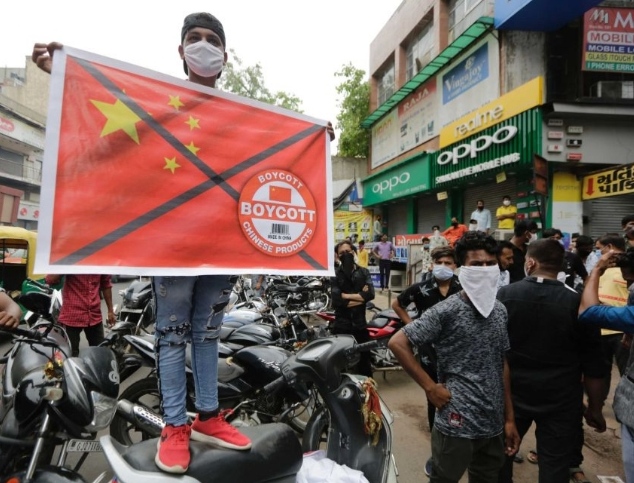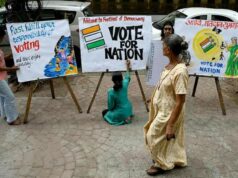Needed to carry out Surgical Strike Against Chinese Economy

Under no circumstances should the Central Government led by PM Modi should let the Chinese government get away with its recent pre-mediated, bloody incursion into the Galwan Valley in East Ladakh. With its typical rank opportunism and subterfuge, the PLA marched into Indian territory.
While the rest of the world, including India, was preoccupied with tackling the on-going pandemic—ironically one created due to China’s carelessness of letting it out of its country—President Xi Jinping chose the current time to pursue his widely known expansionary designs.
What is painful is that once again, as in 1962, we have been lulled into believing both countries would follow the much talked about Wuhan and Mahabalipuram spirit of friendly neighbours to resolve matters amicably, including festering border disputes, a la the Doklam dispute of 2017.
Militarily and diplomatically, the Indian leadership and armed forces will weigh in all options and undoubtedly do what the new developments at the Line of Actual control call for.
A 2019 Balakot type of aerial bombing over China would not be desirable since it will inevitably lead to serious conflict—an escalation. China has a bigger defence force and a much larger military budget and an all-out armed conflict may not be in India’s best interests. All other options, however, must remain on the table.
Apart from Galwan Stand Off, China has been taking action against Indian trade for quite some time. It has imposed hundreds of tariff and non tariff barriers and recently “lured” our traditional friends Nepal and Bangladesh by granting zero duty status on 97% of items exported by them. It has alongside offered Kathmandu four ports for supplies of goods to cut reliance on India.
Earlier it granted deeper duty cuts to India’s other competitors including Pakistan, ASEAN, Australia, South Korea and Peru. Under these circumstances there is no reason for us to stick to pro-liberalisation stance in foreign trade.
While the Chinese economy may be four and a half times India’s, it is still a developing nation, and similar to most rapidly growing countries, remains fragile and vulnerable to shocks
While the Chinese economy may be four and a half times India’s, it is still a developing nation, and similar to most rapidly growing countries, remains fragile and vulnerable to shocks.
But before initiating any overt economic action, we should prepare for a multitude of reprisals against us. That compels us to go after China gradually, in a graded manner and after teaming up with countries with interests aligned with ours.
Post COVID-19, except for a handful of countries like Pakistan and North Korea, the Chinese circle of committed nations is fast depleting. With the US now openly hostile to it, its foreign trade, capital flows, currency management etc are no longer on solid bases.
With a growing number of developed as well as emerging nations now increasingly sympathetic to India, our carefully crafted interventions should be aimed at first identifying and then effectively targeting China where it hurts them most.
An area of potential focus could be the huge imports of minerals into China to sustain its rapid industrial growth, Despite being well endowed with many minerals, China imports 67% of its need of crude oil, 95% of chrome, 90% of cobalt, 79% of gold and 73% of copper.
It also relies heavily on foreign iron ore, thermal coal, hard coke, nickel and lithium to develop both the existing and emerging strategic industries, which include magnets and batteries for a variety of uses including electric vehicles, consumer electronics, mobile phones, aircraft engines and military hardware.
To ensure their on-going supply and check the soaring import bill, it has been attempting to build a successful overseas mineral base.
While India acting alone may not be enough, concerted and well planned actions by India, along with Japan, Australia, the United States and possibly South Korea and Indonesia, can exert enormous leverage on the mining-countries and prevent China’s unchecked international sourcing of minerals from them.
Working in sync with big buyers such as Japan, South Korea and the US, all these poor mineral bearing countries in Africa, South America and Asia would need to be offered comparable buying—quantities, prices, tenures of contracts and better than the Chinese terms of acquisition of mining assets. Of course, alongside, the much needed physical and social infrastructure would need to be funded in these poor nations.
In our bilateral trade with China, we have considerable flexibility. China has not been able to convince WTO of being a market economy and last week, it had to withdraw its appeal against the decision to continue to treat it as a Non Market Economy (NME).
This allows trading partners to question every export consignment from China and puts the onus on the exporter to establish that the quoted prices are not unduly low and based on hidden subsidies.
Steep customs duties on all cheap imports combined with high quality standards particularly those which “kill” Indian labour intensive industries and “non-essentials” like toys, Agarbattis, Smart TVs, mobile phones, paints, varnishes and air-conditioners are totally warranted.
So would be similar measures, though after some preparations by Indian importers, on auto and bicycle components, chemicals, APIs for pharmaceuticals, batteries, solar cells etc. Together, these can reduce our trade deficit by$8.4 bn or 17.3 %.
Prohibition of imports from China of strategic products on security considerations, would cover electronics, semi-conductors and the machinery going into the rapidly expanding defence, telecommunications, information technology, power, railways and ports. Also action is needed to check the inflow of Chinese funds and trade finance by its banks and private equity funds into these sensitive segments.
There should be no dilution of our opposition to joining the regional trade pact RCEP. Acceptance of the criterion of 35% local content to determine the country of origin must be insisted upon. Otherwise a sizeable portion of Chinese exports to us would also come from Hong Kong and the ASEAN group.
In the government procurement business including their PSUs, restrictions are imperative. For domestic funded projects, outright bans on participation by Chinese companies is warranted—though to continue with the facilities extended by World Bank, ADB etc., some convincing would be required.
There is clear evidence to cite to them of the Chinese authorities insisting their IT hardware equipment-makers provide them access to stored data and telecom giants Huawei and ZTE taking several global missteps.
India should follow the US and the EU nations and not let Chinese firms participate in its 5G trials and rollout. Instead, it be developed indigenously with minimum inputs from even non-China players.
There is little doubt that even such carefully thought-through measures, conceived and executed jointly with like-minded nations, are going to impose short term costs on the Indian government, its businesses and its consumers. In fact, this might further contract the already shrinking economy.
But in the longer run, such an “economic surgical strike” would be highly rewarding; geopolitically, for fair trade and for the economy’s movement towards benevolent self–reliance.
To set these in motion, there is no better time than now when the mass of Indian citizenry, and many globally, have come out clearly in favour of boycotting China.



